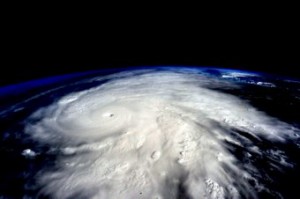Tropical Storm Risk (TSR), one of the leading forecasters of Atlantic seasonal hurricane activity, has updated its prediction for the 2016 Atlantic Hurricane Season, saying it now expects an above average level of activity. Meanwhile, NOAA has forecast a near normal season in 2016.
 Back in April TSR, which is supported by reinsurance broker Aon Benfield, said that it forecast the 2016 Atlantic tropical storm and hurricane season would produce 12 named storms, 6 hurricanes and 2 major hurricanes, which was a prediction for a slightly below normal season.
Back in April TSR, which is supported by reinsurance broker Aon Benfield, said that it forecast the 2016 Atlantic tropical storm and hurricane season would produce 12 named storms, 6 hurricanes and 2 major hurricanes, which was a prediction for a slightly below normal season.
In its latest update at the end of last week TSR increased that forecast significantly, calling for the 2016 hurricane season to produce 17 named tropical storms, with 9 becoming hurricanes and 4 intense hurricanes.
That’s now a forecast that hurricane activity in 2016 will be about 30% above the 1950-2015 long-term average and about 40% above the recent 2006-2015 10-year norm, and the figures include the pre-season storm Alex.
With the season beginning this week interests in the reinsurance, insurance and ILS sector will be on alert for any sign of storm formation. Tropical storm Bonnie this weekend proved to be no threat, rather a rain event and not as significant as the region affected had seen in spring storms. It is important when considering these forecasts to also note that with Bonnie we are now two named storms into the season already.
TSR says that it has increased its forecast for the following reasons:
The recent trend towards negative North Atlantic Oscillation conditions which favour warmer hurricane main development waters in August-September, and to the increased likelihood that La Niña will form by August-September which favours lower trade wind strength, increased vorticity and lower vertical wind shear where hurricanes form.
However TSR also notes that:
Despite the expectation for an active hurricane season in 2016, sources of uncertainty remain including in the forecast strength of La Niña and in how warm the tropical North Atlantic will be in August-September. Furthermore variance exists in the level of hurricane activity possible from the same climate factors.
You can download the full forecast update from the Tropical Storm Risk website.
Meanwhile, the U.S. NOAA Climate Prediction Center has released its pre-hurricane season forecast, stating the agency expects the most likely probability is for a near-normal season, with a 70% likelihood of 10 to 16 named storms (winds of 39 mph or higher), of which 4 to 8 could become hurricanes (winds of 74 mph or higher), including 1 to 4 major hurricanes (Category 3, 4 or 5; winds of 111 mph or higher).
NOAA also notes that it forecasts a 30% chance of an above-normal season and a 25 percent chance of a below-normal season and its figures again also include pre-season Alex.
“This is a more challenging hurricane season outlook than most because it’s difficult to determine whether there will be reinforcing or competing climate influences on tropical storm development,” commented Gerry Bell, Ph.D., lead seasonal hurricane forecaster with NOAA’s Climate Prediction Center. “However, a near-normal prediction for this season suggests we could see more hurricane activity than we’ve seen in the last three years, which were below normal.”
Bell also explained:
There is uncertainty about whether the high activity era of Atlantic hurricanes, which began in 1995, has ended. This high-activity era has been associated with an ocean temperature pattern called the warm phase of the Atlantic Multi-Decadal Oscillation or AMO, marked by warmer Atlantic Ocean temperatures and a stronger West African monsoon. However, during the last three years weaker hurricane seasons have been accompanied by a shift toward the cool AMO phase, marked by cooler Atlantic Ocean temperatures and a weaker West African monsoon. If this shift proves to be more than short-lived, it could usher in a low-activity era for Atlantic hurricanes, and this period may already have begun. High- and low-activity eras typically last 25 to 40 years.
In addition, El Niño is dissipating and NOAA’s Climate Prediction Center is forecasting a 70 percent chance that La Niña — which favors more hurricane activity — will be present during the peak months of hurricane season, August through October. However, current model predictions show uncertainty as to how strong La Niña and its impacts will be.
The addition of the latest TSR forecast and NOAA’s hurricane season forecast for 2016 to our list of forecasters, now gives us an Artemis average forecast for the 2016 hurricane season of 13.9 named storms, 7.4 hurricanes and 3.2 intense hurricanes, which would be an above average season.
So again, the latest forecasts reinforce the need for insurance, reinsurance, insurance-linked securities (ILS) and catastrophe bond interests to remain alert as we near the official start of the season on 1st June.
Reinsurance, ILS and catastrophe bond capital at risk is, of course, significant and with forecasts now suggesting an above average season, with some factors that could encourage greater risk of U.S. landfall (warm sea surface temperatures and the onset of La Nina particularly, 2016 looks set to be a year to watch in the Atlantic tropics.
Also read:
– La Niña development could mean greater re/insurance industry losses.
– La Niña watch, 50% chance of U.S. hurricane strike in 2016: Forecasters.
– 2016 hurricane forecasts, La Niña & SST’s suggest more active season.
 View all of our Artemis Live video interviews and subscribe to our podcast.
View all of our Artemis Live video interviews and subscribe to our podcast.
All of our Artemis Live insurance-linked securities (ILS), catastrophe bonds and reinsurance video content and video interviews can be accessed online.
Our Artemis Live podcast can be subscribed to using the typical podcast services providers, including Apple, Google, Spotify and more.































